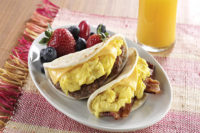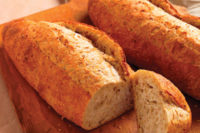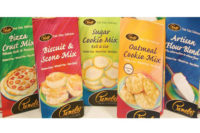New influences, trends and preferences are redirecting many bakers to develop and produce new products. The Food Safety Modernization Act (FSMA) is still a critical issue, as are commodities, private-label products and many business consolidations. Still, bakers are managing to rise to the occasion, and please customers and consumers with products that answer the call of exciting food trends.
Welcome to our State of the Industry issue on the bakery market. From all of the data we’ve gathered, this year, as in the past, the market continues to have its ups and downs. While bread and baked goods can sometimes be taken for granted by restaurateurs, foodservice owners, marketers and retailers, bakery items mean a lot to consumers and carry the clout of tradition, family ownership, pride and other powerful messages. Innovators are listening to consumers and customers alike, and turning the tides toward top-quality, healthful, handy and “free-from” (gluten- and allergy-free) product introductions and line extensions.
Artisan quality, whole grains, exotic flavors and textures, Middle Eastern, Asian, Latin, Eastern European and other global influences are modifying the look and feel of breads, rolls, cookies, bagels, bars, tortillas/flatbreads, pies, pizza and frozen baked goods.
Bold and exotic flavors are where it’s at right now, from a consumer’s point of view, and bakers are joining their restaurant and supermarket customers in developing bold-tasting products. Bakers are eager to please consumers with spicy sriracha, hot sauces, jalapeno, habanero and serrano peppers, sweet chili, aioli, honeyed red pepper and many others. Vegetarian foods are also a fast-growing segment that bakery customers, like restaurants and foodservice outlets, are fostering. In fact, vegan specialty restaurants serving delicious meatless meals aren’t a rarity any more.
Adding more nutrients, addressing the protein trend and adding seeds, ancient grains and whole wheat are big trends. The frozen pizza category is stereotypically an unhealthy one, fraught with high sodium, high preservatives, cholesterol and fat. But manufacturers are changing this by differentiating their brands with healthier ingredient profiles.
Consolidations aplenty
Another issue impacting the baking and snack industries is the many company consolidations. Several bakery buyouts, as well as mergers and joint ventures, were reported. Headlines read that Flowers Foods’ took over Hostess assets; Grupo Bimbo bought Sara Lee’s bread business, Beefsteak and Canada Bread; Weston Foods purchased Rubschlager Baking; Pepperidge Farm is closing its bakery in Aiken, S.C.; C.H. Guenther & Son is acquiring Tribeca Oven; Hain Celestial is buying Rudi’s Organic Bakery; Aryzta AG is purchasing Pineridge Bakery in Ontario and Cloverhill Bakery in Chicago; and the list goes on. Even Mondelez says it’s restructuring to become “a leaner, simpler and more focused organization by reducing operating costs to best-in-class levels through zero-based budgeting and by accelerating its supply-chain reinvention initiative.”
And with shoppers buying less but spending more in this difficult economy, bread might be sacrificed for another item in the shopping cart.
But according to IRI, a Chicago-based market research firm, sales of fresh bread and rolls were up this year (for the last 52 weeks ending April 20), at $13.894 billion, though it has been a tough year.
Food safety is also top of mind, with bakers and snack manufacturers alike. Most of the bakers we’ve talked with are participating in or have become certified with either a Global Food Safety Initiative (GFSI)-recognized or similar food-safety compliance program. The preliminary results of a recent study on the efficacy and business impact of the implementation of GFSI-recognized schemes demonstrate that food-safety management systems are indeed more effective, delivering greater confidence in the safety of the products provided to the consumer.
Many of the GFSI’s survey respondents say that certification compliance has indeed enhanced their ability to produce safe food. They also indicate that it helps them improve their compliance procedures with existing regulations and better prepares them for future regulatory changes.
A few additional results of the GFSI’s study: 77% of respondents say there is more consistency in their operations and documents; 64% of respondents indicated the process of becoming certified took a year or less; and 87% claim it has been very or fairly beneficial for their business.
Fast, tidy and totable
Portion control and convenience are also in great demand. For cinnamon lovers, Flowers Foods’ Mrs. Freshley’s Cinnamon Coffee Cakes are available in single-serve 3.4-oz. twin-packs to provide a handy and taste-tempting option for breakfast, coffee time or snack time. ConAgra’s Marie Callender’s single-serve cake twin-packs afford a little piece of decadence in three flavors: Double Chocolate; Red Velvet; and Carrot. Each box contains two 82-g. cakes with 280-300 calories.
Snacking is taking place all day now, and breakfast is primarily on-the-go. Market research firm The Hartman Group, Bellevue, Wash., indicates that there’s a big opportunity for convenience stores and fast-casual restaurants to offer more quality product, as the traditional three-meals-a-day routine continues to wane. Progressive breakfast offerings include new takes on flatbread and artisan bread, flatbread breakfast sandwiches, waffle sandwiches, breakfast tacos and burritos.
Sandwiches—for both breakfast and lunch—featuring innovative bread components—are growing in popularity. “Half of the time, when people are eating, they’re eating snacks,” says Harvey Hartman, founder and chairman of The Hartman Group.
Mintel’s food and drink analyst, Beth Bloom, reported in a 2013 Mintel bread market analysis that “some 81% of bread users utilize bread as part of a sandwich or wrap. “This is more than double that of any other use. The industry should play to its strengths, expanding offerings that allow for sandwich experimentation, at the same time, introducing new formats and flavors [that] will encourage consumers to consider bread as a nutritious meal component or convenient snack.”
Mintel estimated that last year, total U.S. sales of bread products would reach $23.6 billion, an increase of 4% since 2008. While bread is consumed by 99% of households, the category has struggled with small, year-over-year growth. Dietary concerns related to sodium, sugar and carbohydrates can be blamed for part of this shift. Brand volatility, including the sales of Hostess assets, may also play a role here, with its brands disappearing from store shelves for a while.
The gluten-free explosion
New product developments, such as the explosion of gluten-free offerings—now estimated to be a $20-billion industry—may mitigate some of the losses. Gluten-free baked goods are hot, as consumers are more interested than ever in what they eat and where their food comes from.
Gluten-free baked goods are also moving into mainstream outlets, and their quality continues to improve. But there are plenty of misconceptions about gluten-free and other free-from foods, such as their nutrition content, their preparation, the gluten-free labeling rule set to go into effect in August and many other issues.
However, rising commodities costs may result in price increases that can’t be helped. Mintel said that bread manufacturers and marketers “can retain patronage by promoting products as a staple to American meal plans by creating products for specific meal part and day part use, by expanding flavor offerings and by making products available that meet consumer interest in health and affordability.”
And that seems to be just what bakers are doing. They’re creating new flavors and broader taste profiles for all kinds of eating occasions, and simultaneously keeping tabs on their bottom lines, customer service and food safety.
As unpretentious and inexpensive as bread and other bakery products can be on the side or center of the plate, bread can be a powerful menu differentiator in restaurants, at home and on-the-go. Restaurants, foodservice operators, retailers and other customers are paying more attention to artisan preparations, health issues and the chance to create new baked good varieties, flavors and textures.





